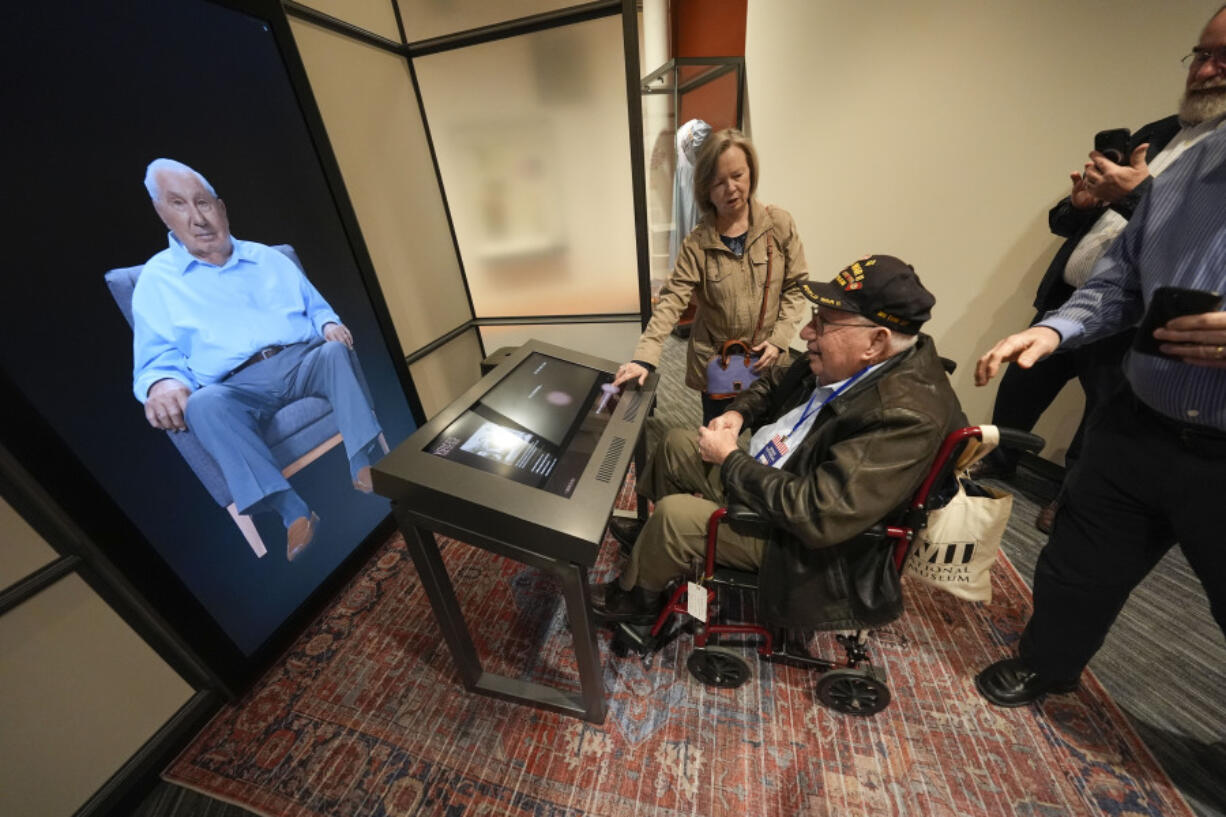NEW ORLEANS — Olin Pickens sat in his wheelchair facing a life-sized image of himself on a screen, asking it questions about being taken prisoner by German soldiers during World War II. After a pause, his video-recorded twin recalled being given “sauerkraut soup” by his captors before a grueling march.
“That was a Tuesday morning, February the 16th,” Pickens’ onscreen likeness answered. “And so we started marching. We’d walk four hours, then we’d rest 10 minutes.”
Pickens is among 18 veterans of the war and its support effort featured in an interactive exhibit that opened Wednesday at the National WWII Museum. The exhibit uses artificial intelligence to let visitors hold virtual conversations with images of veterans.
Pickens of Nesbit, Miss., was captured in Tunisia in 1943 as U.S. soldiers from the 805th Tank Destroyer Battalion were overrun by German forces. He returned home alive after spending the rest of the war in a prison camp.
“I’m making history, to see myself telling the story of what happened to me over there,” said Pickens, who celebrated his 102nd birthday in December. “I’m so proud that I’m here, that people can see me.”
The Voices From the Front exhibit also enables visitors to the New Orleans museum to ask questions of war-era home front heroes and supporters of the U.S. war effort — including a military nurse who served in the Philippines, an aircraft factory worker, and Margaret Kerry, a dancer who performed at USO shows and, after the war, was a model for the Tinker Bell character in Disney productions.
Four years in the making, the project incorporates video-recorded interviews with 18 veterans of the war or the support effort — each of them having sat for as many as a thousand questions about the war and their personal lives. Among the participants was Marine Corps veteran Hershel Woodrow “Woody” Wilson, a Medal of Honor winner who fought at Iwo Jima, Japan. He died in June 2022 after recording his responses.
Visitors to the new exhibit will stand in front of a console and pick who they want to converse with. Then, a life-sized image of that person, sitting comfortably in a chair, will appear on a screen in front of them.
“Any of us can ask a question,” said Peter Crean, a retired Army colonel and the museum’s vice president of education. “It will recognize the elements of that question. And then using AI, it will match the elements of that question to the most appropriate of those thousand answers.”
The exhibit bears similarities to interactive interviews with Holocaust survivors produced by the University of Southern California Shoah Foundation, founded by film director Stephen Spielberg. That project also uses life-sized projections of real people that appear to respond to questions in real time. They’ve been featured for several years at Holocaust museums across the U.S.
Aging veterans have long played a part in personalizing the experience of visiting the New Orleans museum, which opened in 2000 as the National D-Day Museum. Veterans often volunteered at the museum, manning a table near the entrance where visitors could talk to them about the war.
But that practice has diminished as the veterans age and die. The COVID-19 pandemic was especially hard on the WWII generation, Crean said.
Theodore Britton Jr., who served during the war as one U.S. Marine Corps’ first Black recruits, said he was thrilled to help the museum “do by mechanical devices what we’re not going to be around to do in the future.”
The 98-year-old veteran, who was appointed U.S. ambassador to Barbados and Grenada by President Gerald Ford, got a chance Wednesday to question his virtual self, sitting on screen wearing the Congressional Gold Medal that he was awarded in 2012.
“There are fewer and fewer WWII veterans, and a lot of people who will never see one,” Britton said. “But they can come here and see and talk with them.”
The technology isn’t perfect. For example, when Crean asked the image of veteran Bob Wolf whether he had a dog as a child, there followed an expansive answer about Wolf’s childhood — his favorite radio shows and breakfast cereal — before he noted that he had pet turtles.
But, said Crean, the AI mechanism can learn as more questions are asked of it and rephrased. A brief lag time after the asking of the question will diminish, and the recorded answers will be more responsive to the questions, he said.



